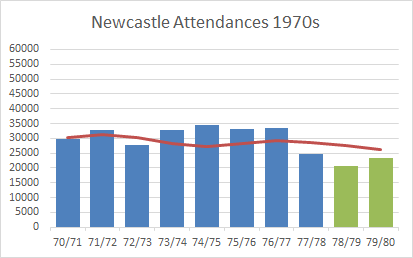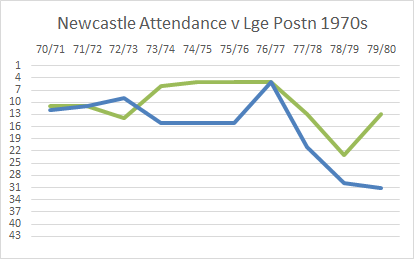
Bars = NUFC average - Red line = D1 average

Green = Attendance position - Blue = League position -
| Season | Ave | D1 Ave | Att Pn | Lge Pn |
| 70/71 | 29,762 | 30,205 | 11 | 12 |
| 71/72 | 32,659 | 31,324 | 11 | 11 |
| 72/73 | 27,779 | 30,257 | 14 | 9 |
| 73/74 | 32,861 | 28,294 | 6 | 15 |
| 74/75 | 34,614 | 27,239 | 5 | 15 |
| 75/76 | 33,057 | 28,333 | 5 | 15 |
| 76/77 | 33,529 | 29,389 | 5 | 5 |
| 77/78 | 24,719 | 28,692 | 13 | 21 |
| 78/79 | 20,494 | 27,428 | 23 | 30 |
| 79/80 | 23,345 | 26,327 | 13 | 31 |
The steady decline in the number of people attending matches since the fifties continued unabated throughout the decade. The average Division 1 attendance in 1969/70 was 32,074, by the end of the seventies it had dropped by a fifth to 26,327.
Newcastle's average in the same period fell from 37,553 (1969/70) to 23,345 (1979/80) but had fallen as low as 20,494 in 1978/79. This drop obviously reflecting United's dramatic decline as much as any general trend.
The 1977/78 season saw United drop out of the top flight and the 7,986 crowd that witnessed the last game of the season was the worst turnout since before The First World War. A year later and only 7,134 saw the last game against Wrexham.
As usual there was a lot of soul searching within the game and many factors were put forward. Too much football on the television, boring football (the average number of goals per game in D1 fell to an all-time low of 2.54), player indiscipline, rising unemployment, poor facilities and last but certainly not least hooliganism
On January 1971 sixty six people lost their lives and over a hundred were injured when barriers collapsed during the Rangers Celtic derby at Ibrox. It was an accident waiting to happen as many British grounds were in a very poor state of repair and there was inadequate crowd control at big games.
The Government commissioned a study and within months The Wheatley Report was published which recommended that football grounds should have to meet the same health and safety laws as other entertainment venues such as cinemas. However it took another four years for the Safety at Sports Ground Act to become law.
Newcastle had been attempting to upgrade St. James' for years, but the deadlock with the council was as entrenched as ever as the decade began. Perhaps the Ibrox disaster clarified their thinking because soon after agreement was reached on a new one million pound stadium which was to be developed over a 10-year period.
Phase 1 started with the demolishing of the Popular Side that ran alongside Leazes Terrace (1971/72) and the construction of the East Stand in its place just over a year later. Significantly the cost was £420,000; almost half the anticipated cost for the whole stadium.
But in the rest of the ground there were very few improvements and there was a near disaster in the FA Cup match against Man City in 1976/77 when surges within the crowd at the Gallowgate caused crushing at the front with children having to be hoisted out onto the cinder track.
A lack of cash and the need to invest almost £400,000 in the ground to comply with the new regulations delayed further work until 1977/78 when the Leazes End was demolished in preparation for a new stand. But the money ran out and the Leazes became an empty shell for the next 15 years.
Hooliganism blighted football throughout the decade. It occurred before, during and after matches and neither the football authorities nor the politicians were capable of coming up with a solution.
During every season there were incidents of fighting, missile throwing, pitch invasions and wanton destruction of property. Town centres became no-go areas for some on a Saturday afternoon as extra policing within the grounds simply led to the trouble spilling out into the surrounding areas.
Fans of some clubs gained a worse reputation than others and there is no doubt that the Newcastle hooligans caused lots of trouble both at home and away. Indeed in 1974/75 a Leeds police chief described them as the second worst behind Manchester United.
Their exploits were often on the front pages of the local newspapers and the 1974 FA Cup invasion against Forest and the 1980 West Ham petrol bomb incident earned national coverage.
Embed from Getty ImagesNewcastle Supporters Club went from strength to strength and they certainly tried their best to curtail the trouble amongst Magpie supporters.
Fans travelling with the club were not allowed to bring alcohol and at various times there were bans on "unfriendly looking" boots and "half-mast" trousers.
In 1974/75 they became the first Supporters Club in Britain to introduce ID cards; without which you couldn't travel on any official excursions.
In the same season the club celebrated it's 20th anniversary and also (with the help of United's good cup runs) it reached 5,000 members for the first time.
Travel to matches was still invariably by coach, but train travel was organised for certain trips with the club hiring a carriage. The League bought it's own train "The League Liner" in 1972/73 and this was made available to United supporters for the first time for the 1973/74 cup match at West Brom. A lack of the advertised features made it a bit of a let down.
Wrecking of trains on more than one occasion meant that "soccer specials" were eventually withdrawn for a period.
In 1976/77 the club moved to its new premises in the now destroyed prefabs of Prudhoe Place.
In the first couple of seasons United struggled and the crowd were often demanding "we want our money back." whilst certain players (especially Tommy Gibb) were singled out for special treatment by the Gallowgate boo boys.
A survey of fans carried out by the Sunday Sun at the end of 1971/72 revealed that 79% would accept an increased risk of defeat if it meant more attacking football whilst 60% thought more money needed to be spent on improved facilities.
United gradually became a more attacking, if inconsistent team and the match day experience was generally nore enjoyable.
Allocation of tickets for Cup matches was an ongoing issue. At the start of the decade it was the very unpopular first come first served . For the 1974 Cup Final vouchers were issued at one particular match which were then used in a "raffle".
Failure in the 1974 Cup Final saw the fans turn on manager Harvey and he was "moved upstairs" but for some the move backfired when instead of the "big name" replacement they had craved they got the very short named (and "unknown") Lee Gordon.
1975/76 saw Cup (near glory) and the usual League disappointment. Lee was trying to change United's style and when they were winning Gordon Lee had the "Black 'n' White Army behind him but when things were not going so well the mood was only black. There were calls for the board and manager to go and a sit-down protest in the Gallowgate.
The sale of Supermac was the next big issue the fans had to wrestle with and there was even talk of a fans boycott; when Lee followed him out the door five months later the antagonism towards the board went up a few more notches.
Relegation was to follow with the inevitable drop in attendances and rise in despondency.
Whilst most fans made do with chants and abuse shareholder, Malcolm Dix decided more formal action was required and he called for an extraordinary general meeting during 1976/77 with the aim of passing a vote of "no confidence" in the Board.
United's surprise qualification for Europe and a concerted smear campaign by the Board prevented him from achieving his aims.
Undeterred he formed the Newcastle United Supporters Association during the following season (1977/78) with the aim of "having the name of Newcastle United spoken with pride once more".
In order to achieve this he wanted new younger directors on the Board and argued for the need to issue shares to raise extra capital and over the next couple of seasons he attempted to raise support among the smaller shareholders.